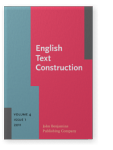Vol. 4:1 (2011) ► pp.29–53
N-rhemes in English problem–solution texts
It has been claimed that the last constituent of the clause, the N-rheme, is the part of the message which the writer wants the reader to remember and which is most likely to correlate with the goals of the text (Fries 2002). This study investigates the N-rhemes in two samples of problem–solution texts written by advanced Swedish learners of English and British university students, respectively. It was found that the majority of the N-rhemes in both samples are concerned with the chief elements of problem–solution texts, i.e. with the description of the problem, different means of solving it and the evaluation of both. It was also found that a small proportion of the N-rhemes formed progressions from their preceding theme or rheme. Five broad types of semantic connections were distinguished, Continuation, Expansion, Contrast, Summation, and Enhancement, each of which contributes to the unfolding discourse in different ways. Continuation and Expansion N-rheme progressions are used, for instance, to emphasise and elaborate on the writer’s point, Contrast and Summation N-rheme progressions to organise the content, and Enhancement N-rheme progressions to develop aspects of circumstantial meaning. The texts by advanced Swedish learners, which are written in a somewhat subjective and emphatic style, contain a greater number of Expansion and Continuation N-rheme progressions than the texts written by the British students, whose style of writing is expository and less personal.
Cited by (2)
Cited by 2 other publications
This list is based on CrossRef data as of 1 july 2024. Please note that it may not be complete. Sources presented here have been supplied by the respective publishers. Any errors therein should be reported to them.
